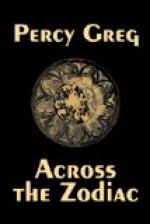On the sixth day, I perceived another nebula, and on this occasion in a more promising direction. It appeared, from its gradual movement, to lie almost exactly in my course, so that if it were what I suspected, and were not at any great distance from me, I must pass either near or through it, and it would surely explain what had perplexed and baffled me in the case of the former nebula. At this distance the nature of the cloudlet was imperceptible to the naked eye. The window telescope was not adjustable to an object which I could not bring conveniently within the field of view of the lenses. In a few hours the nebula so changed its form and position, that, being immediately over the portion of the roof between the front or bow lens and that in the centre of the roof, its central section was invisible; but the extremities of that part which I had seen in the first instance through the upper plane window of the bow were now clearly visible from the upper windows of either side. What had at first been a mere greatly elongated oval, with a species of rapidly diminishing tail at each extremity, had now become an arc spanning no inconsiderable part of the space above me, narrowing rapidly as it extended downwards and sternwards. Presently it came in view through the upper lens, but did not obscure in the least the image of the stars which were then visible in the metacompass. I very soon ascertained that the cloudlet consisted, as I had supposed in the former case, of a multitude of points of light less brilliant than the stars, the distance between which became constantly wider, but which for some time were separately so small as to present no disc that any magnifying power at my command could render measurable. In the meantime, the extremities visible through the other windows were constantly widening out till lost in the spangled darkness. By and by, it became impossible with the naked eye to distinguish the individual points from the smaller stars; and shortly after this the nearest began to present discs of appreciable size but somewhat irregular shape. I had now no doubt that I was about to pass through one of those meteoric rings which our most advanced astronomers believe to exist in immense numbers throughout space, and to the Earth’s contact with or approach to which they ascribe the showers of falling, stars visible in August and November. Ere long, one after another of these bodies passed rapidly before my sight, at distances varying probably from five yards to five thousand miles. Where to test the distance was impossible, anything like accurate measurement was equally out of the question; but my opinion is, that the diameters of the nearest ranged from ten inches to two hundred feet. One only passed so near that its absolute size could be judged by the marks upon its face. This was a rock-like mass, presenting at many places on the surface distinct traces of metallic veins or blotches, rudely ovoid in form, but with a number of broken surfaces,




